JIN Zhimin,DUAN Yan,TONG Liga,JIA Xuehui,YUAN Qian, ZHANG Hongbo,JIN Ye*
(College of Food Science and Engineering,Inner Mongolia Agricultural University,Hohhot010018,China)
Abstract:The objective of this study was to test the cholesterol-lowering activity of lactic acid bacterial(LAB)strains in traditional Inner Mongolian fermented sausages.Eight LAB strains isolated from fermented sausages were screened for their cholesterol degradation ability using phthalic aldehyde colorimetric method.Strain X 3-2Bhad the strongest ability to remove cholesterol.The improved cholesterol removal ability was observed when MRS broth was supplemented with3g/L oxgall,20g/L cholesterol and20g/L glucose.Cholesterol removal rate by this strain was signi☒cantly higher than that by the commercial strain L. plantarum in a variety of media and during different fermentation periods.The cholesterol content in X 3-2Bfermented sausage was significantly lower than the control group(ranged from88to63mg/100g).In conclusion, X 3-2Bhas the potential to degrade cholesterol and is useful as a starter culture for fermented sausages.
Key words:cholesterol; Lactobacillus;Inner Mongolia;fermented sausage;fermentation
We hypothesized that the thousands of years of natural selection of LAB in fermented sausages in Inner Mongolia area might provide strains with high superior ability to hydrolyze cholesterol in meat products.The objective of this work was to screen probiotic strains for their cholesterol removal ability suitable as starter cultures for the fermented sausages,and to further characterize factors affecting their ability to hydrolyze cholersterol,as well as its application in fermented sausages.
1.1 Strains and culture media
Eight st rains of LAB were isolated from the native fermented sausage of Inner Mongolia;L. plantarum (a2m1.191)was purchase from Guangdong culture collection center.
MRS broth,Meat model(beef extract20g/L,peptone20g/L,glucose10g/L,NaCl30g/L,sodium nitrite0.15g/L),MRS+60g/L NaCl+150mg/kg NaNO 2were used.
1.2 Cholesterol degradation analysis
1.2.1 Growth of bacterial cultures
Overnight cultures were added at1%(V/V)to MRS-THIO(supplemented with0.2%sodium thioglycolate)broth supplemented with3g/L oxgal and20g/L cholesterol.Resulting cholesterol level was approximately100mg/L in the medium.Un-inoculated sterile broth was used as control.After24h incubation at30℃statically,bacterial cells were harvested by centrifugation(12000r/min,for10min)and the resulting supernatant was assayed fo r cholesterol content [11-12]. 1.2.2Quantitative assay of cholesterol
The cholesterol levels were determined by o-phtalaldehyde [13]content and calculated based on a standard curve.Percentage degradation was calculated as the followed:
All experiments were replicated thrice.
1.2.3 Optimizing fermentation conditions
One strain,X 3-2B,with the highest cholesterol degradation ability was selected for further optimizing fermentation conditions [14].
1.2.4 Effects of bile on cholesterol degradation
Screened strain(X 3-2B)was inoculated into MRS-THIO broth with1,2,3,4,5g/L oxgal and20g/L cholesterol and incubated at30℃for24h.Degradation of cholesterol was quantified as described [15].The cholesterol removal ability of X 3-2Bwas expressed as the percentage of cholesterolreduction.All the experiments were repeated three times.L. plantarum was used as positive control.
1.2.5 Effects of glucose and NaCl on cholesterol degradation
The overnight X 3-2Bculture was inoculated into MRS-THIO broth supplemented with3g/L oxgal and20g/L cholesterol supplemented with variable concentration of glucose(0,20,40,60and80g/L)and/or NaCl(0,20,40,60,80g/L).incubated at30℃for24h [16].Degradation of cholesterol was quantified as described.
1.2.6 Growth characteristics of the selected lactic acid bacteria
Overnight X 3-2Band L. plantarum cultures were added at2%to the media of MRS,MRS+60g/L NaCl+150mg/kg NaNO 2and meat model which were supplemented with3g/L oxgal and20g/L cholesterol.Cholesterol removal rate after fermented1,2,4,6and8d at30℃were measured [16].Uninoculated broth was used for control.All the experiments were repeated three times.
1.2.7 Cholesterol removal ability in fermented sausages
Three different groups of sausage were produced.Shoulder meat of Shunite sheep was used and back fat in the ratio of80:20.The control was comprised of sausages which don’t contain starter;Then second group is produced with L. plantarum and third group is produc ed with X 3-2B(screened) [17].
The determination of pH,enumeration of LAB and cholesterol content was performed on days0,3,6and9.All tests were performed in triplicate using three sausage samples per treatment.pH was measured by pH-Star(Matth☒us);Number of LAB was measured by method of Ali Gücükoğlu [18];Cholesterol content was determined by Cholesterol kit(BioSenTe c Lot:28-12091) [19].
1.3 Statistical analyses
The data was analyzed using the GLM procedure of the Statistical Analysis Systems(SAS Institute,Cary,NC).
 of means(SEM)were reported and means were separatedOne-way ANOVA.Statistical significance was considered as P<0.05.
of means(SEM)were reported and means were separatedOne-way ANOVA.Statistical significance was considered as P<0.05.
2.1 Cholesterol removal ability
Eight strains demonstrated cholesterol removal ability by49.95%-68.92%(Table1).The variations among them in cholesterol remove were signi☒cant in the presence of the mixture of bile salts(P < 0.05).Six strains(X 3-1,X 3-2B,X 3-3B,X 3-13B,X 7-1b,HX 2-4)provided moderate removal and few of them(X 3-4Band X 3-5B)were inferior to the L. plantarum(61.76±5.31)%,pH of strain X 3-2Bin MRS and MRS-THIO were decreased to3.86±0.01and5.35±0.01after24h.
As one of the beneficial health effects related to probiotics,for a starter culture for fermented sausage manufacture,we consider cholesterol removal ability of Lactobacillus strains has been much more important and cholesterol removal ability is considered a major requirement.Among all the eight strains,strain of X 3-2Bhas the highest cholesterol removal rate and was then used for further study.
Table1Acid production and cholesterol-reducing ability of LAB in MRS-THIO brothbroth
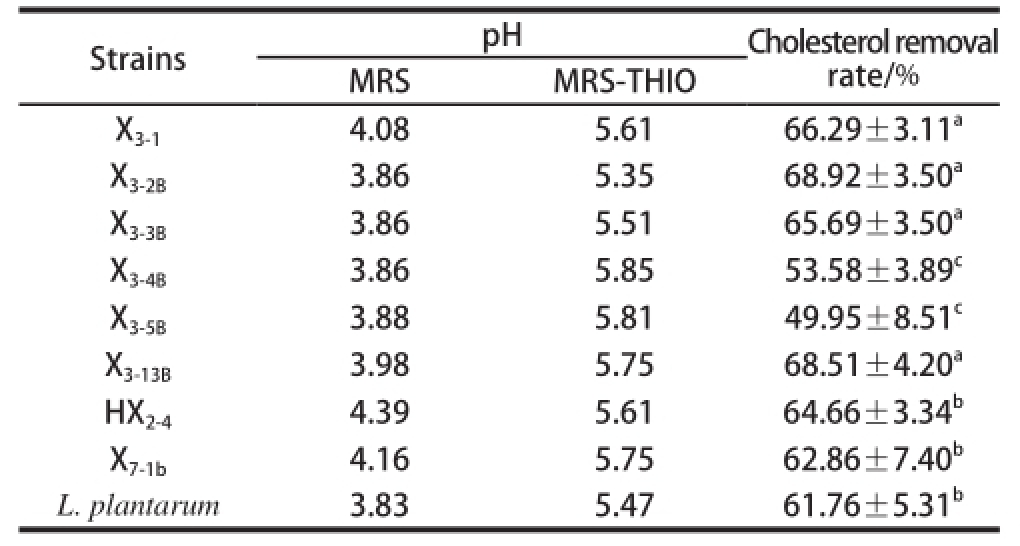
Note: Mean values with different letters in the same column are signifi cantly different (P < 0.05). The same as in Table2,3.
StrainspHCholesterol removal rate/% MRSMRS-THIO X 3-14.085.6166.29±3.11 aX 3-2B3.865.3568.92±3.50 aX 3-3B3.865.5165.69±3.50 aX 3-4B3.865.8553.58±3.89 cX 3-5B3.885.8149.95±8.51 cX 3-13B3.985.7568.51±4.20 aHX 2-44.395.6164.66±3.34 bX 7-1b4.165.7562.86±7.40 bL. plantarum3.835.4761.76±5.31 b
2.2 Effect of bile on cholesterol removal
Table2Cholesterol removal ability of strain XainX 3-2B3-2Bof LAB in relation tion to bile and cholesterol concentrationation
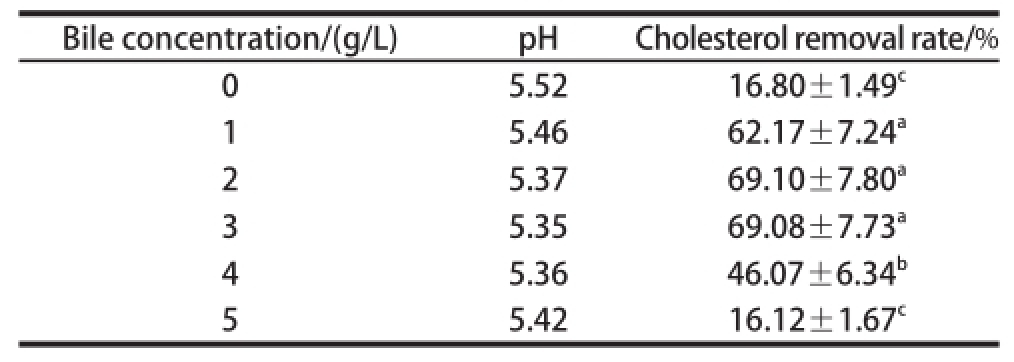
Bile concentration/(g/L)pHCholesterol removal rate/% 0 5.5216.80±1.49 c1 5.4662.17±7.24 a5.3769.10±7.80 a3 5.3569.08±7.73 a4 5.3646.07±6.34 b5 5.4216.12±1.67 c2
In recent years,many reports have been published on cholesterol removal from laboratory media containing bile and cholesterol in the lactobacilli [20].There was no significant difference in pH at different bile content and there was a significant(P < 0.05)increase at bile concentration between1-3g/L,compare to the control,however,reduction was much lower at4g/L bile concentration and not sighificant at5g/L(Table2).2g/L Oxgall increases the cholesterol tolerance by changing the fatty acid composition of the cells and reduced the cellular leakage caused by bile salts.BILIGE et al. [19]studied the Lactobacillus which was isolated from the home-made koumiss in mongolia,and discovered the ability of sodium taurocholate deconjugation(with the amount of cholic acid liberated2.95μmol/L),cholesterol removal rate was52%(highlighted its probiotic potential).
Its presence in the medium affects strain growth.Thus,as the comparison with the difference of☒nal cholesterol concentration,co-precipitation of cholesterol with deconjugated bile was measured by the difference between the☒nal cholesterol concentration in MRS broth supplemented with bile and without bile.We found no ch olesterol could be removed without bile salts,neither co-precipitation nor assimilation.Higher cholesterol reduction was noted when the cholesterol concentration was higher than1g/L.Results indicated that supplementation of bile salt in the growth medium was presumed to be a critical element for cholesterol assimilation.Zhang Min et al. [21]indicated that cholesterol assimilation,binding to cell surface and incorporation into cellular membrane were the main reason of removal of cholesterol from fermentation media.Cholesterol removal ability can also be affected by its environment condition [22]and Yildiz et al. [23]found that there was a decrease in LAB cells which were inoculated in MRS broth supplemented with100g/L cholesterol and3g/L oxgall compared with the control.
2.3 Effect of glucose and NaCl on cholesterol removal
The Cholesterol-reducing ability of X 3-2Bin different concentration of glucose and NaCl are present in Table3.The re was no significant(P > 0.05)decrease at NaCl concentration in MRS-THIO broth between40g/L and60g/L,their cholesterol reduction was much higher than other concentration(Up to69%).There was a significant(P < 0.05)increase at glucose concentration between40,60and80g/L,compare to no glucose group,however,reduction was much higher at20g/L glucose concentration.Although the effect on cholesterol removal would be modes in the presence of different content of glucose and NaCl,we found when the glucose up to20g/L and NaCl is suitable forstrain to grow and the cholesterol removal rate was greatest.This result was same as Italian salami where the highest concentration of NaCl is about50g/L [24].
Table 3 Changes in pH and cholesterol removal rate of X3-2B expressed in different concentrations of glucose and NaCl after 24 h of MRS-THIO broth
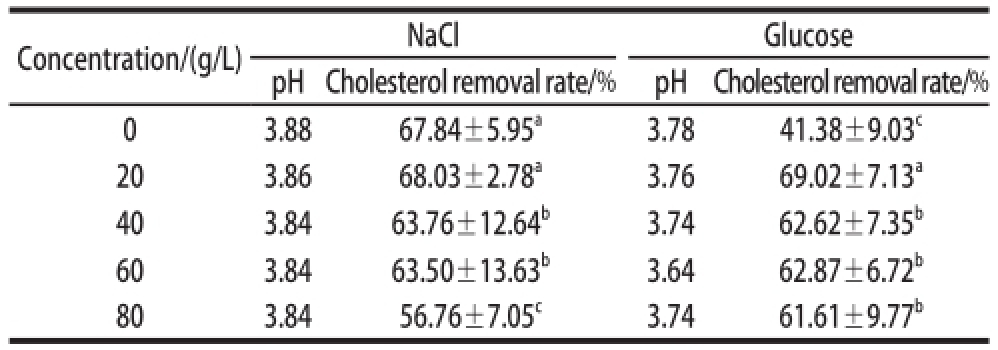
Concentration/(g/L)NaClGlucose pHCholesterol removal rate/%pHCholesterol removal rate/% 0 3.8867.84±5.95 a3.7841.38±9.03 c203.8668.03±2.78 a3.7669.02±7.13 a403.8463.76±12.64 b3.7462.62±7.35 b603.8463.50±13.63 b3.6462.87±6.72 b803.8456.76±7.05 c3.7461.61±9.77 b
2.4 Broth effect on growth ability
Table4Cholesterol degradation ooff XX 33--22BBaanndd L. plantaarruumm in differreenntt fermentation periods and different brrootthhss
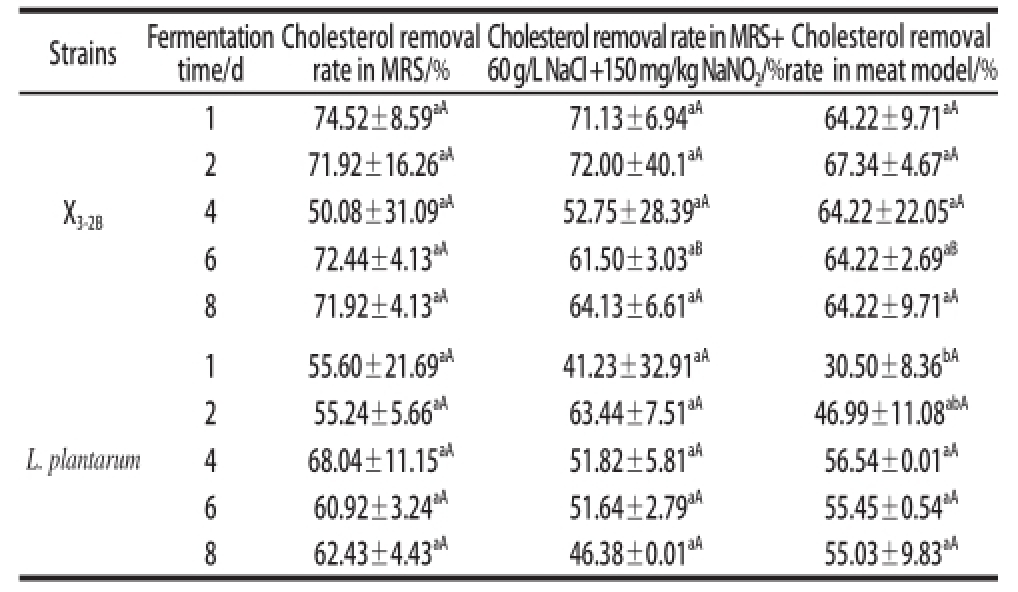
Note: Different lowercase letter in the same column differ significantly (P < 0.05);different capital letter in the same line differ significantly(P < 0.05).The same as in Table5.
StrainsFermentation time/d Cholesterol removal rate in MRS/% Cholesterol removal rate in MRS+ 60g/L NaCl+150mg/kg NaNO 2/% Cholesterol removal rate in meat model/% X3-2B 174.52±8.59 aA71.13±6.94 aA64.22±9.71 aA271.92±16.26 aA72.00±40.1 aA67.34±4.67 aA450.08±31.09 aA52.75±28.39 aA64.22±22.05 aA672.44±4.13 aA61.50±3.03 aB64.22±2.69 aB871.92±4.13 aA64.13±6.61 aA64.22±9.71 aA155.60±21.69 aA41.23±32.91 aA30.50±8.36 bA255.24±5.66 aA63.44±7.51 aA46.99±11.08 abA468.04±11.15 aA51.82±5.81 aA56.54±0.01 aA660.92±3.24 aA51.64±2.79 aA55.45±0.54 aA862.43±4.43 aA46.38±0.01 aA55.03±9.83 aAL. plantarum
Cholesterol-reducing ability of X 3-2Band L. plantarum in different media and fermenting time are present in Table4.Binding abilities of these strains to cholesterol removal rate were fermented time and strain dependent.Strain of X 3-2Bshowed no significant difference in different fermented time while in same media and in different media while in same fermenting time,however,reduction was significant(P < 0.05)higher after fermenting6d in MRS broth.Strain of L. plantarum showed greatest cholesterol-reducing rate after obs erved fermented4d in media MRS containing cholesterol,however,reduction was higher after fermented2d in media MRS+0.06g/mL NaCl+150mg/kg NaNO 2containing cholesterol.
In general,the cholesterol removal rate of strains in media MRS were greater(P < 0.05)for other media.Acid potential of X 3-2Bin MRS+0.06g/mL NaCl+150mg/kg NaNO 2broth was higher than in meat model which may be due to nutrient limitation.Perhaps,continuous culture of these cells acclimatized with cholesterol may exhibit higher levels of cholesterol [25].
2.5 Cholesterol removal ability in fermented sausage
Table 5 Overall effect of different starter cultures on lactic acid bacteria counts, pH and cholesterol content in fermented sausages
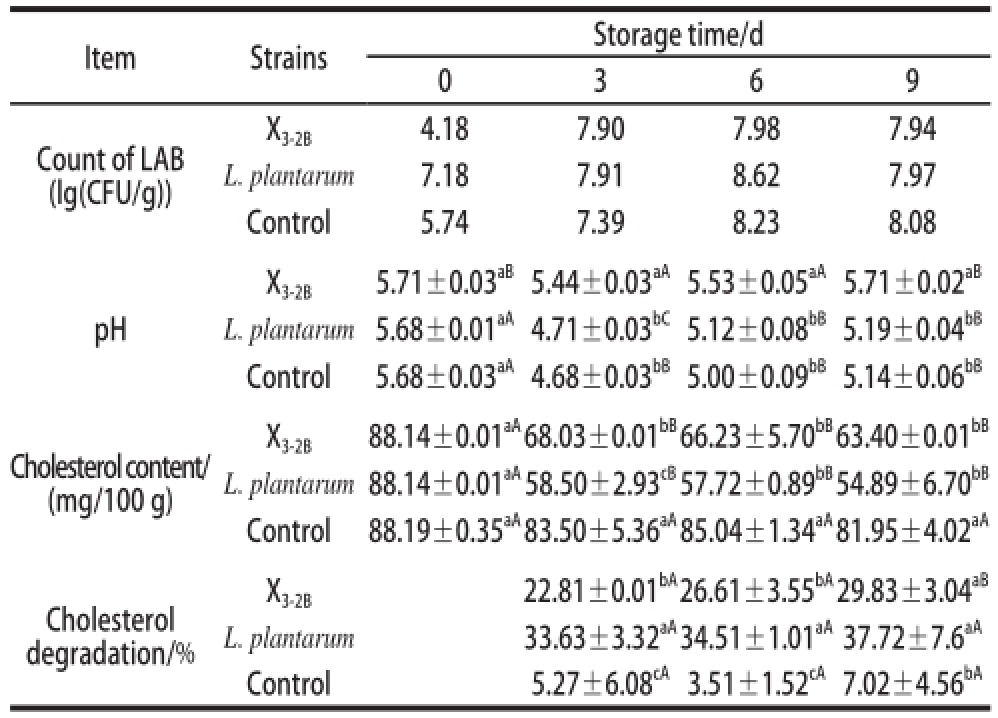
ItemStrainsStorage time/d 0 3 6 9 Count of LAB(lg(CFU/g))X 3-2B4.187.907.987.94 L. plantarum7.187.918.627.97 Control5.747.398.238.08 pH X 3-2B5.71±0.03 aB5.44±0.03 aA5.53±0.05 aA5.71±0.02 aBL. plantarum5.68±0.01 aA4.71±0.03 bC5.12±0.08 bB5.19±0.04 bBControl5.68±0.03 aA4.68±0.03 bB5.00±0.09 bB5.14±0.06 bBCholesterol content/(mg/100g)X 3-2B88.14±0.01 aA68.03±0.01 bB66.23±5.70 bB63.40±0.01 bBL. plantarum88.14±0.01 aA58.50±2.93 cB57.72±0.89 bB54.89±6.70 bBControl88.19±0.35 aA83.50±5.36 aA85.04±1.34 aA81.95±4.02 aACholesterol degradation/% X 3-2B22.81±0.01 bA26.61±3.55 bA29.83±3.04 aBL. plantarum33.63±3.32 aA34.51±1.01 aA37.72±7.6 aAControl5.27±6.08 cA3.51±1.52 cA7.02±4.56 bA
Cholesterol contents of the sausages significantly (P < 0.05)decreased with increasing count of la ctic acid bacteria.The greatest cholesterol content was found in the20%fat sausages in first day.Cholesterol content of starter culture group was a significant(P < 0.05)decrease after fermented3,6and9d,however,Cholesterol content was significant lower than control group in same fermenting time.After the sixth day of ripening,there was the largest count of LAB in fermented sausage.When the count of LAB of X 3-2Band L. plantarum was increased from4to8(lg(CFU/g))and7to8(lg(CFU/g)).Then cholesterol degradation of X 3-2B,L. plantarum and control were29.83%,37.72%and7.02%after9d fermented respectively.pH of different strains were decreased promptly after3d fermented,then increasing steadily after that.Group of control has lowest pH in ripening.
The product of Sausage is a process with the addition of spice,salt,carbohydrate and other additives to the uncooked meat and fat which were riven and then☒lling of sausage stuff into natural or synthetic covers,it includes ripening and drying period at certain temperatures and relative moisture [10].However,cholesterol removal by the screened strain X 3-2Bwas signi☒cantly higher than that of the commercial strain L. plantarum,during8d of growth.More cholesterol being precipitated on deconjugation of sodium glycocholate than sodium taurocholate,co-precipitation of cholesterol with cholic acid was observed from deconjugation of both conjugated bile [5],Cholesterol removal rate of screened strain X 3-2Bhad a decrease after fermented4d,further research onthis matter is required.The c holesterol content in fermented sausage ranged from88.14mg/100g to63.40mg/100g.
In conclusion,most of the eight strains,X 3-2Bwas noted of its ability on cholesterol removal.Successful application of the selected strains as a cholesterol removal starter cultures for the fermented sausage was demonstrated.As cultures originating from meat with potential probiotic properties and cholesterol removal activity could contribute to enhance the hygienic quality of the products and provide signi☒cant health bene☒ts.So strain of X 3-2Bwas noted of it’s ability on removal cholesterol and its suitable as starter cultures for the fermented sausages.
References:nces
[1]OUWEHAND A C,SALMINEN S J.The health effects of cultured milk products with viable and non-viable bacteria[J].International Dairy Journal,1998,8:749-758.
[2]PENN ACCHIA C,ERCOLINI D,BLAIOTTA G,et al.Selection of Lactobacillus strains from fermented sausages for their potential use as probiotics[J].Meat Science,2004,67(2):309-317.
[3]BACC IGALUPI L,di DONATO A,PARLATO M,et al.Small surface-associated factors mediate adhesion of a food-isolated strain of Lactobacillus fermentum to Caco-2cells[J].Research in Microbiology,2005,156(7):830-836.
[4]SHAH N P.Functio nal cultures and health bene☒ts[J].International Dairy Journal,2007,17:1262-1277.
[5]SIMO NOV☒M,STROMPFOV☒V,MARCIŇ☒KOV☒M,et al.Characterization of Staphylococcus xylosus and Staphylococcus carnosus isolated from Slovak meat products[J].Meat Science,2006,73(4):559-564.
[6]STAJIĆ S, ŽIVKOVIĆ D, PERUNOVIĆ M, et al.Cholesterol content and atherogenicity of fermented sausages made of pork meat from various breeds[J].Procedia Food Science,2011,1:568-575.
[7]BONOMO M G,RICCIARDI A,ZOTTA T,et al.Molecular and technological characterization of lactic acid bacteria from traditional fermented sausages of Basilicata region(Southern Italy)[J].Meat Science,2008,80(4):1238-1248.
[8]SMITH J L,PALUMBO S A.Use of starter cultures in meats[J].Food Protection,1983,46:997-1006.
[9]HEEJAE L,HONGSUP Y,YOSEP J,et al.Functional properties of Lactobacillus strains isolated from kimchi[J].International Journal of Food Microbiology,2011,145(1):155-161.
[10]HOLZAPFEL W H,GEISEN R,SCHILLINGER U.Biological preservation of foods with reference to protective cultures,bacteriocins and food-grade enzymes[J].Food Microbiology,1995,24:343-362.
[11]LIONG M T,SHAH N P.Bile salt deconjugation ability,bile salt hydrolase activity and cholesterol co-precipitation ability of lactobacilli strains[J].International Dairy Journal,2005,15(4):391-398.
[12]JENS H,CHRISTINA P.Anaerobic mineralization of cholesterol by a novel type[J].Archives of Microbiology,1997,167:269-274.
[13]MATHARA J,SCHILLINGER U,GUIGAS C,et al.Functional characteristics of Lactobacillus spp.from traditional Maasai fermented milk products in Kenya[J].International Journal of Food Microbiology,2008,126(1/2):57-64.
[14]KLINGBERG T D, AXELSSON L,NATERSTAD K,et al.Identification of potential probiotic starter cultures for Scandinaviantype fermented sausages[J].International Journal of Food Microbiology,2005,105(3):419-431.
[15]ERKKIL☒S,PET☒J☒E.Screening of commercial meat starter cultures at low pH and in the presence of bile salts for potential probiotic use[J].Meat Science,2000,55(3):297-300.
[16]PAPAMANOLI E,TZANETA KIS N,LITOPOULOU-TZANETAKI E,et al.Characterization of lactic acid bacteria isolated from a Greek dry-fermented sausage in respect of their technological and probiotic properties[J].Meat Science,2003,65(2):859-867.
[17]PAULO C B C,BIBIANA A,ROGER W.Amorphous cellulose gel as a fat substitute in fermented sausages[J].Meat Science,2012,90(1):36-42.[18]GÜCÜKOĞLU A,K☒PL☒L☒☒.The effect of different starter cultures and ripening temperatures on formation of biogenic amine in Turkish fermented sausages[J].European Food Research and Technology,2010,230(6):875-884.
[19]BILIGE M,WU Rina,WANG L ip ing,et al.Evaluation of potential probiotics properties of the screened lactobacilli[J].Annals of Microbiology,2009,59(3):493-498.
[20]HUANG Ying,WANG Xiaojun,WANG Jinfeng,et al.Lactobacillus plantarum strains as potential probiotic cultures with cholesterol-lowering activity[J].Journal of Dairy Science,2013,96(5):2746-2753.
[21]ZHANG Min,HANG Xiaomin,FAN Xiaobing,et al.Characterization and selection of Lactobacillus strains for their effect on bile tolerance,taurocholate deconjugation and cholesterol removal[J].World Journal of Microbiology and Biotechnology,2007,24(1):7-14.
[22]de ALMEIDA JACKIX E,MONTEI RO E B,RAPOSO H F,et al.Cholesterol reducing and bile-acid binding properties of taioba(Xanthosoma sagittifolium)leaf in rats fed a high-fat diet[J].Food Research International,2013,51(2):886-891.
[23]YILDIZ G G,☒ZT☒RK M,ASLIM B.Identification of Lactobacillus strains from breast-fed infant and investigation of their cholesterolreducing effects[J].World Journal of Microbiology and Biotechnology,2011,27(10):2397-2406.
[24]KIMOTO H,OHMOMO S,OKAMOTO T.Cholesterol removal from media by lactococci[J].Journal of Dairy Science,2002,85(12):3182-3188.
[25]PRITI N,CHAUDHARI,BHUSHAN L.Cholesterol biotransformation toandrosta-1,4-diene-3,17-dione by growing cells of Chryseobacterium gleum[J].Biotechnology Letters,2010,32:695-699.
降胆固醇乳酸菌的筛选及其在内蒙古发酵香肠中的应用
靳志敏,段艳,通力嘎,贾雪晖,袁倩,张宏博,靳烨*
(内蒙古农业大学食品科学与工程学院,内蒙古呼和浩特010018)
摘要:通过对乳酸菌降胆固醇生物学特性及对发酵肉制品中胆固醇降解作用进行研究,结果表明,从内蒙古传统肉肠中分离筛选得到的8株乳酸菌中,菌株X 3-2B有较强的胆固醇降解能力。且在MRS培养基中添加3g/L胆盐、20g/L胆固醇和20g/L葡萄糖时菌株X 3-2B的胆固醇降解能力最大,在不同培养基中发酵不同时间菌株X 3-2B对胆固醇的降解能力显著高于标准菌株。在以菌株X 3-2B为发酵剂的发酵香肠中,其胆固醇含量显著低于对照组。故菌株X 3-2B可作为一株降胆固醇性能较好的肉制品发酵剂。
关键词:胆固醇;乳酸菌;内蒙古;发酵香肠;发酵特性
中图分类号:TS251.5
文献标志码:A
文章编号:1002-6630(2015)05-0099-05
doi:10.7506/spkx1002-6630-201505019
It is well recognized that probiotics are beneficial to human health [1]and the relationship between fermented foods and their health bene☒ts have been investigated for many years [2].Lactic acid bacteria(LAB)are among major bacterial species in human guts,which have demonstrated the beneficial effects of LAB.There is a high demand for probiotic products by consumers these years and the food industry is keen to develop new fermented products which are noted with their health benefits [3].In recent years,reduction in serum cholesterol have been claimed for the main characteristic of probiotic bacteria [4].
Fermented sausages are excellent carrier for LAB,since these products are not heated and can harbour high numbers of lactic acid bacteria.Fermented meat products have been produced for thousands of years.Many countries have their traditional meat products,where the most frequently used starter cultures are LAB [5].The process is characterised by a series of biochemical transformations related to the development of microflora,the consequences of which are acid-producing ability,and the change of structure,colour and flavour of the final product [6].In Europe,Lactobacillus are most commonly used starter cultures in the production offermented sausages [7-8].Traditional fermented meat products in the Inner Mongolia contain about20%chopped fat which is rich in cholesterol.The ideal characteristics required for LAB used in fermented meat products are being resistant to nitrite and sodium chloride,of capability of activation and promotion of growth ratio during fermentation and ripening and proper acid production,bile resistant and able to colonize the human intestinal tract [9].Fermented foods are still produced by traditional methods in most developing countries and they are the important part in daily diet [10].
收稿日期:2013-11-12
基金项目:“十二五”国家科技支撑计划项目(2012BAD13B02)
作者简介:靳志敏(1985—),女,博士,研究方向为食品质量与安全。E-mail:jzm201009@126.com
*通信作者:靳烨(1964—),男,教授,博士,研究方向为食品科学。E-mail:jinyeyc@sohu.com